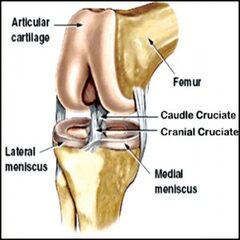 An article by veterinarian Rob McCarthy, which I recently read,
discusses the different surgical procedures used to treat dog cruciate
ligament problems.
An article by veterinarian Rob McCarthy, which I recently read,
discusses the different surgical procedures used to treat dog cruciate
ligament problems. The first of these
procedures is the lateral fabellotibial suture or lateral suture. The
procedure has been used for almost about thirty years now and it still
considered quick, affordable, and safe. Most veterinary surgeons would
recommend the procedure on dogs less than 20 kg, and in most cases near
normal function was restored.
In 1993, a new
cruciate ligament surgical procedure was introduced by Dr. Barclay
Slocum. The tibial plateau leveling osteotomy (TPLO) involves changing
the angle of the knee joint by doing an osteotomy or cutting of bone,
making the joint more stable and placing less strain on the cruciate
ligament. Although the complication rate is higher, dogs that have the
surgery are able to recover faster. The procedure is best for large
arthritic or athletic dogs.
More recently,
two new surgical techniques were introduced on treating cruciate
ligament injury treatment. They can be thought of as variations on the
TPLO - the tibial tuberosity advancement and the triple tibial
osteotomy. The two procedures use existing tendons and an osteotomy to
make the affected joint stable. The two procedures seem to be most
effective for large dogs.
What Dog Cruciate Technique to Choose?
It
was mentioned in the article that cranial cruciate ligament injury is
the most common cause of lameness in the stifle joint (knee). The
article says that according to the Wall Street Journal, the number of
cruciate ligament surgeries in dogs exceeds that in humans in the USA,
and the estimated repair cost of these surgeries was about 1.23 billion
dollars in 2003.
This startling information
just shows that cruciate ligament injury is a possibility dog owners
should be ready to face. As a dog owner, being informed has never been
more important. When your dog needs cruciate ligament surgery the
following must be taken into consideration.
- How expensive is the procedure? The lateral suture surgery may be an old technique but it is quick and relatively affordable. The newer procedures are at least twice as expensive.
- What are the complications? Dog owners should know that surgery is invasive procedure and carries with it some risks. Possible complications of the lateral suture surgery include pain, infection, breaking the suture, a sore back, trigger points and tears to the cartilage pads (meniscii). Also, the procedure results in the thickening and swelling around the joint that may suggest dog arthritis. The newer procedures carry additional risk since these surgeries require pieces of bone to be cut off and repositioned, which does not always go well.
- How long will it take for my dog to recover? The newer procedures recover quicker, providing an advantage for big or arthritic dogs.
- How effective are these procedures? It is hard to identify which of the procedures is surgically superior. All surgical techniques have success rate of 95% and can restore your dog’s movement to near normal.
All
of the procedures mentioned are effective but there is still a need for
more research to clearly identify the strengths and weaknesses of each
technique. That is why I agree with Dr. McCarthy when he mentioned in
his article, “Dogma, common belief, and professional opinion should be
questioned, evaluated, and authenticated.”
When your dog need s cruciate ligament surgery, it is important that you discuss everything with your vet.
Dog Cruciate Ligament Surgery (PDF)
